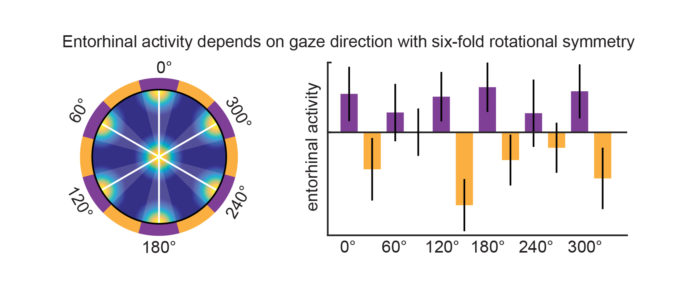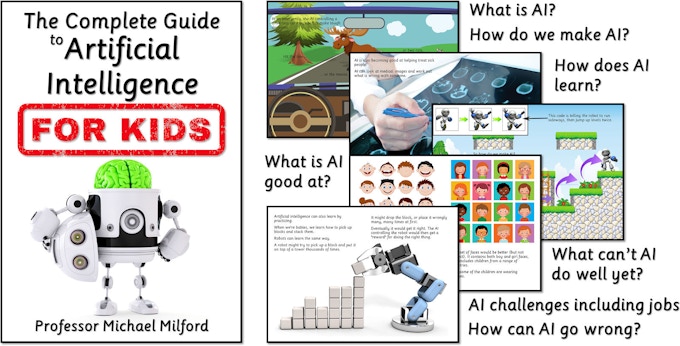
Brief News of Cognitive Navigation (2018-001)
1. Hexadirectional coding of visual space in human entorhinal cortex
by Matthias Nau, Tobias Navarro Schröder, Jacob L. S. Bellmund & Christian F. Doeller in DoellerLab, January 8, 2018

- Entorhinal grid cells map the local environment, but their involvement beyond spatial navigation remains elusive.
- The researchers examined human functional MRI responses during a highly controlled visual tracking task and show that entorhinal cortex exhibited a sixfold rotationally symmetric signal encoding gaze direction.
- The results provide evidence for a grid-like entorhinal code for visual space and suggest a more general role of the entorhinal grid system in coding information along continuous dimensions.
The entorhinal cortex is a crucial part of the brain’s navigation system but its function beyond navigation remains unclear. In the new study published in Nature Neuroscience, they examined entorhinal fMRI activity in a highly controlled viewing paradigm and show that the same mechanisms used to represent where we are, also represent where we look.
Entorhinal grid cells encode a map of the environment by being active at distinct locations organized into a six-fold rotationally symmetric lattice spanning space. Earlier work from the DoellerLab has shown that functional magnetic resonance imaging (fMRI) is sensitive to this six-fold symmetrical grid-cell signature when participants navigate in virtual environments. While most work on grid cells has historically focused on rodents, our experience of the world as humans might differ drastically from mice and rats. One prominent difference is that humans have a much better eyesight than rodents and use vision to a greater extent to explore their environment. Monkeys in contrast share many similarities with us in the way they see their environment. “We were therefore very excited when grid cells in monkeys were shown to encode where the monkey was looking in the world” says Matthias, the first author of the present study. “Given the strong similarities in viewing behavior between monkeys and humans, they then wondered whether human entorhinal cortex encodes visual space in a similar way to that observed in monkeys”.
They set out to answer this question and designed an experiment allowing us to tightly control eye movements while participant’s brain activity was monitored using fMRI. Participants followed a moving dot with their eyes and memorized locations of colored circles on the screen. In addition to their brain activity, they recorded where they were looking during this task. When analyzing activity of the entorhinal cortex, they found that it indeed exhibited the same six-fold symmetrical signature of grid cell activity that we knew from their navigation studies. Crucially however, their current experiment did not involve navigation, but focused exclusively on eye movements and visual exploration.
“These results are very exciting for us because they reveal that the brain’s navigation system represents a map of visual space” explains Christian. “Seeing that the same neural mechanisms that guide navigation are used to represent also other types of information, shows that the contributions of the entorhinal cortex to human cognition are even richer than we previously thought”. They published these results together with another group making similar observations (Julian et al. 2018) in the January 2018 issue of Nature Neuroscience.
By demonstrating that the brain’s navigation system encodes a map of visual space, their study bridges the knowledge gaps between spatial, perceptual and cognitive neuroscience, as well as between rodent, monkey and human research. It takes a significant step beyond previous studies and adds an important piece to the exciting puzzle we call human cognition.
Read further info on the DoellerLab website or paper on Nature Neuroscience
2. The Complete Guide to Artificial Intelligence for Kids
By Professor Michael Milford Jan 9, 2018
The Complete Guide to Artificial Intelligence for Kids helps young kids get a grip on AI, and in doing so helps prepare them for their future. Prepare kids for an AI-filled future with this full color illustrated guide to the key concepts in Artificial Intelligence.

The guide touches on all the key issues in AI, including:
- What is AI?
- Neural network-based AI and biological intelligence
- How does AI learn? Training AI, and comparisons to how we learn.
- The importance of appropriate data for training AI and the potential for discrimination
- What can AI do well? Covering topics like image recognition, medicine, games…
- What does AI not do well (at least currently)? Covering topics like emotions, creativity, music, painting, unexpected situations…
- Challenges for AI including topics like driverless car decision making
- Potential problems including AI taking jobs and military AI
As a Professor of Robotics, Michael get a better preview of the future than most. He has been able to visit and see behind the scenes at the world’s top technology corporations (including Google, Microsoft, Amazon and Elon Musk’s OpenAI), start-ups and research labs (including Harvard, Oxford and MIT).
It will be a very different world, one full of robots, self-driving cars, automation; with artificial intelligence (AI) driving it all.
Read further more info on the website
3. 2017: DeepMind’s year in review
by Demis Hassabis, Mustafa Suleyman, Shane Legg at DeepMind

The approach they take at DeepMind is inspired by neuroscience, helping to make progress in critical areas such as imagination, reasoning, memory and learning. Take imagination, for example: this distinctively human ability plays a crucial part in our daily lives, allowing us to plan and reason about the future, but is hugely challenging for computers. They continue to work hard on this problem, this year introducing imagination-augmented agents that are able to extract relevant information from an environment in order to plan what to do in the future.
Other techniques they worked on this year, such as distributional reinforcement learning, population based training for neural networks and new neural architecture search methods, promise to make systems easier to build, more accurate and quicker to optimise.
In October they took another step by launching DeepMind Ethics & Society, a research unit that will help us explore and understand the real-world impacts of AI in order to achieve social good.
Their belief is that AI will be able to do the same for other complex problems, as a scientific tool and a multiplier for human ingenuity. The AlphaGo team are already working on the next set of grand challenges and they hope the moments of algorithmic inspiration they helped to create are just the beginning.
Read further more info on the DeepMind website.
About
CogNav Blog
New discovery worth spreading on cognitive navigation in neurorobotics and neuroscience
Recent Posts
- How to build a bio-inspired hardware implementation of an analog spike-based hippocampus memory model?
- How does the brain select what to remember during sleep?
- How hippocampal activity encodes numerous memories of specific events in life?
- How egocentric coding properties arise from its presynaptic inputs, and how egocentric cells represent items across different behavioral contexts?
- How the medial entorhinal cortex develops during learning and influences memory?
Tags
Categories
- 3D Movement
- 3D Navigation
- 3D Path Integration
- 3D Perception
- 3D SLAM
- 3D Spatial Representation
- AI Navigation
- Bio-Inspired Robotics
- Brain-Inspired Navigation
- Cognitive Map
- Cognitive Navigation
- Episodic Memory
- Excerpt Notes
- Flying Vehicle Navigation
- Goal Representation
- Insect Navigation
- Learning to Navigate
- Neural Basis of Navigation
- Path Integration
- Path Planning
- Project
- Research Tips
- Robotic Vision
- Self-Flying Vehicles
- Spatial Cognition
- Spatial Cognitive Computing
- Spatial Coordinate System
- Spatial Memory
- Time
- Unclassified
- Visual Cortex
- Visual Cue Cells
Links
- Laboratory of Nachum Ulanovsky
- Jeffery Lab
- BatLab
- The NeuroBat Lab
- Taube Lab
- Laurens Group
- Romani Lab
- Moser Group
- O’Keefe Group
- DoellerLab
- MilfordRobotics Group
- The Space and Memory group
- Angelaki Lab
- Spatial Cognition Lab
- McNaughton Lab
- Conradt Group
- The Fiete Lab
- The Cacucci Lab
- The Burak Lab
- Knierim Lab
- Clark Spatial Navigation & Memory Lab
- Computational Memory Lab
- The Dombeck Lab
- Zugaro Lab
- Insect Robotics Group
- The Nagel Lab
- Basu Lab
- Spatial Perception and Memory lab
- The Neuroecology lab
- The Nagel Lab
- Neural Modeling and Interface Lab
- Memory and Navigation Circuits Group
- Neural Circuits and Memory Lab
- The lab of Arseny Finkelstein
- The Epstein Lab
- Gu Lab (Spatial Navigation and Memory)
- Fisher Lab (Neural Circuits for Navigation)
- The Alexander Lab (Spatial Cognition and Memory)
- Harvey Lab (Neural Circuits for Navigation)
- Buzsáki Lab
- ……
